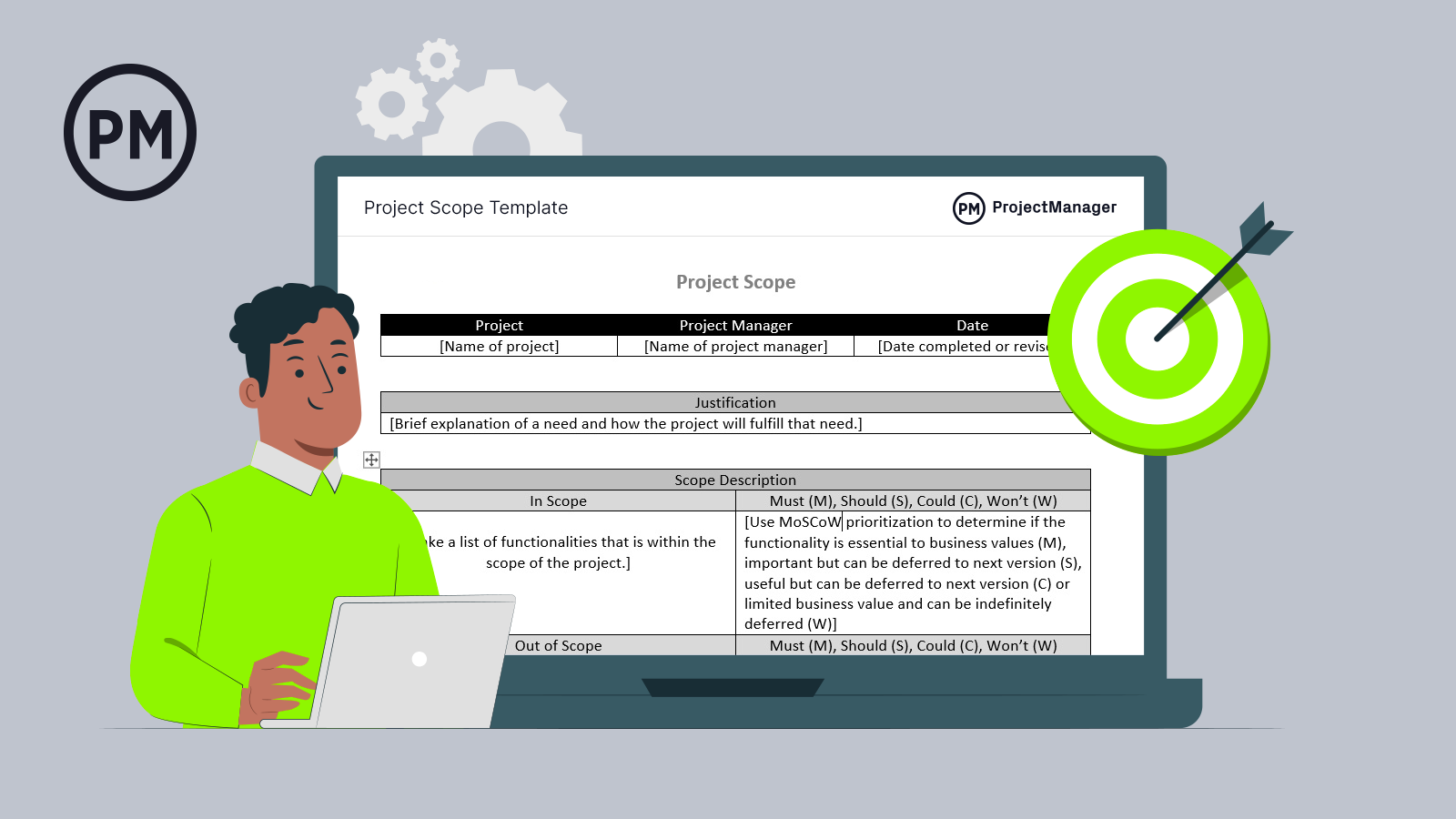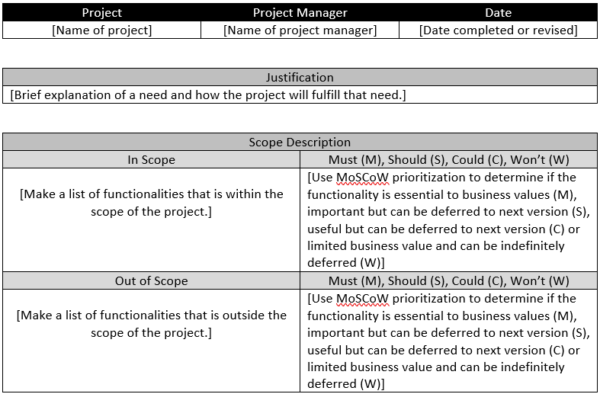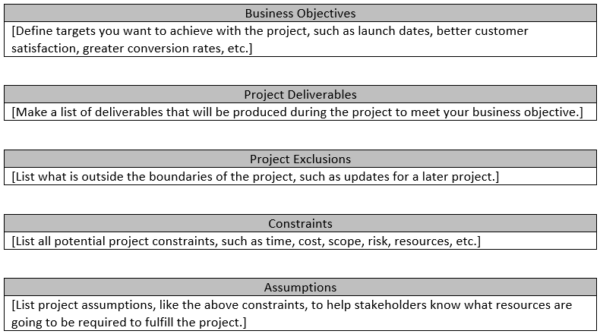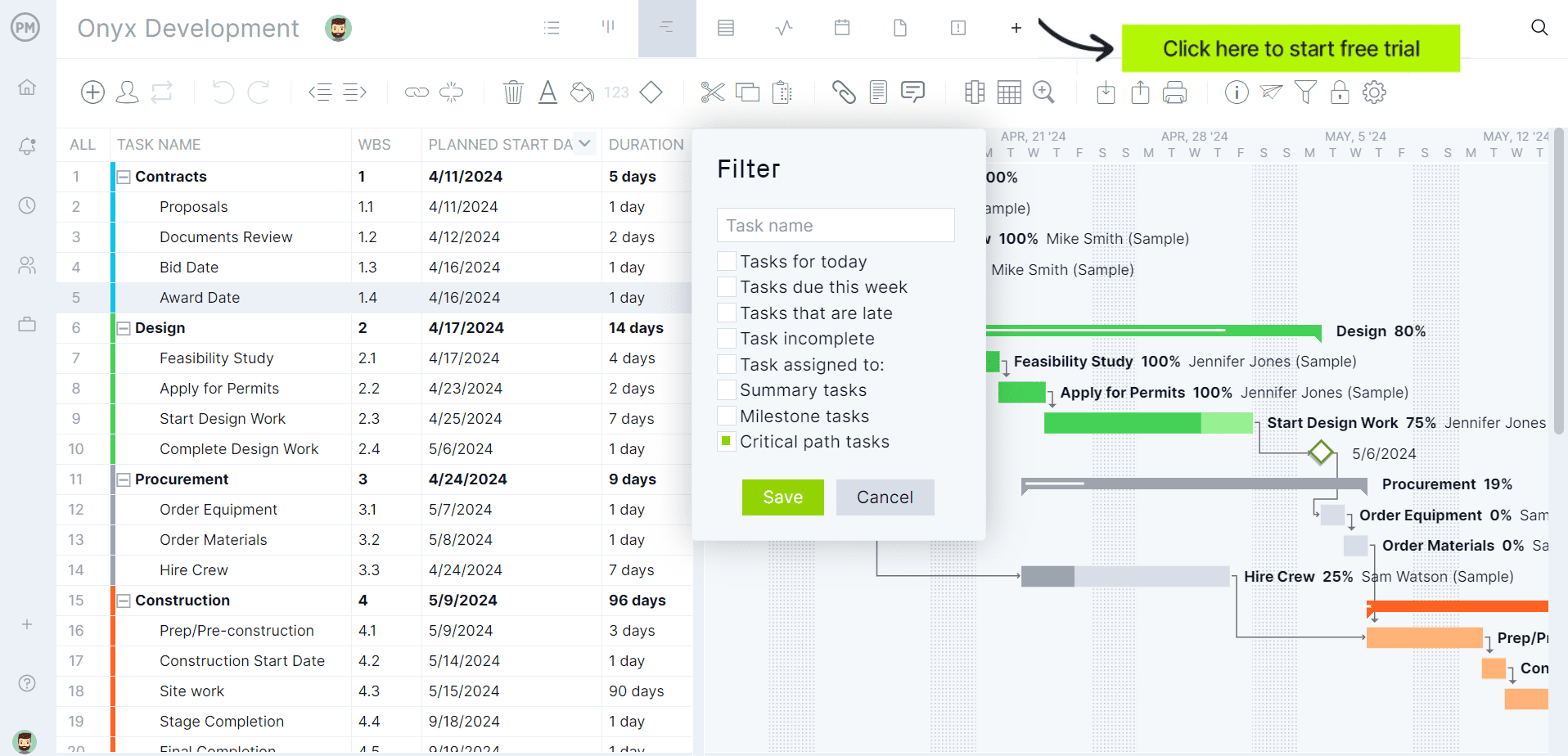The scope of a project is the sum of all the work that needs to be executed. A project scope statement helps project managers define the boundaries of what will and what won’t be done. But scope statements aren’t just about work management.
To write a project scope statement, you’ll need to understand the project goals, work breakdown structure and requirements, among other things. Then, once you’ve defined your project scope, you can create a scope document.
What Is a Project Scope Statement?
A scope statement is a document that defines all the elements of the project scope as well as assumptions, project requirements and acceptance criteria. Your project scope statement will act as the primary tool for stakeholders and teammates to reference and use as a guideline to accurately measure project success.
A project scope statement is part of the scope management plan, a larger document that contains all the strategies, rules and procedures to manage your project scope. In the same way, the scope management plan is an important component of your project plan.

Get your free
Project Scope Template
Use this free Project Scope Template for Word to manage your projects better.
What Does a Project Scope Statement Include?
This detailed project document defines the boundaries of a project, outlining inclusions and exclusions. Typically, the project scope statement starts with a project description with a brief overview of its purpose and objectives. There’s also a list of tangible and intangible product deliverables as well as defined project objectives.
Project acceptance criteria should also be included to determine whether the project deliverables are acceptable, while project exclusions outline what isn’t included in the project. This document outlines project constraints that may impact the project’s execution and a list of assumptions made during the planning process. Also included in the project scope statement is a detailed scope description, project boundaries, initial project risks and stakeholder acceptance criteria.
Project Scope Statement Sample
To better understand what the project scope statement is, we thought it’d be helpful to visualize it using our free project scope template for Word as a project scope statement example. As you can see, it has the basic project scoping information on top and then goes into a general justification for the project’s need and how it’ll fulfill that.
Then we get into the main part of the project scope statement, such as what will be in scope and out of scope for the project. This creates boundaries for the project and makes clear what is essential and must be prioritized.

Now we get into explanations of the business objectives, such as targets that the project needs to hit in order to be successful, and the deliverables that’ll be produced over the life cycle of the project.
From there, you’ll describe project exclusions, issues of time, cost, scope, risk, resources and so on that could constrain it and whatever is assumed to be done in the project.

Finally, you’ll go into costs. The project scope statement is going to estimate the costs and list them all, including the estimated cost, the actual cost and the cost on completion of the project. Then you can show the variance, which is the difference between the estimated cost and the actual cost.

How to Write a Project Scope Statement
Now that we know what a project scope statement is, let’s learn how to write this important project management document. Similar to the five Ws of journalism—who, what, when, where, why—to properly outline your project scope statement, you must address these seven things:
1. Project Goals & Objectives
Project goals and objectives are what define the purpose of a project. Project objectives are the smaller steps that lead to the project goals, which are broader. Start your project scope document by explaining them. These goals and objectives should be documented in a project charter, too.
2. Project Requirements
Project managers and stakeholders must reach an agreement about the project scope and other project requirements such as the expected quality, risk, benefits and cost, among others.
3. Project Scope Description
It might sound easy enough, but this is the most important step. Here is where you’ll define your project scope, which is all the work that needs to be done to complete the project. Here are some simple steps to help you define the project scope.
- Use a work breakdown structure to visualize all your project tasks, deliverables, and milestones.
- List what’s within the scope of your project, and what’s out of scope. Everything that’s not included in the project scope is known as project exclusions.
- Identify project constraints, which are all the limitations such as time or cost.
- Create a scope baseline to compare your actual progress to the planned project scope.
Project exclusions and constraints are essential because they help establish boundaries for the project to exist. They also manage your stakeholders’ expectations/input and give your team members some creative limitations to work within.
4. Project Exclusions
While it’s imperative that you define the boundaries around what the project includes from the outset, it’s also extremely important that you list what this project doesn’t include. For example:
- Application updates that are planned for a later project and are intentionally not included in this project
- Restricted or rescheduled customer access to certain support lines/product features
5. Project Constraints
Project constraints are what make managing projects such a puzzle to solve. The top three constraints to managing any project are typically time, money and scope, known as the triple constraint of project management. They’re interconnected, meaning that if you pull one lever on ‘scope,’ another lever on ‘money’ or ‘time’ will also move.
But there are additional project constraints that can crop up at any time, including risk, resources, organization, method, customers and more. List all the constraints you foresee in your project, so you can try to have solutions in place ready to launch when needed.
6. Project Assumptions
Your project assumptions typically revolve around the very things that end up being constraints, including time, money and scope. For example, it’s in this section of your project scope document, “the front-end development team will be available during this project time period,” or, “the customer support team will receive new product training by x time.” It’s important to list these out as this won’t only tell key stakeholders what your primary resource needs are to make the project go, but it also gives you fast insight as to where your biggest risk factors lie.
7. Project Deliverables
List out the deliverables your team members need to produce in order to meet business objectives. This can include the product itself, instruction and installation manuals, marketing materials, press releases, advertising campaigns and more.
Your project scope statement outline helps act as a marker as you build out your full scope statement. Because while predicting the future of the project is impossible at such a high level, this is the first step to getting your project as close to the outcome as possible. By starting with the seven key statements above, you can get a head start on a successful project.
Gantt charts are the workhorses of scope management. However, most Gantt chart software is woefully limited in terms of its functionality. ProjectManager has dynamic online Gantt charts that do the regular organizing, prioritizing and linking dependencies and adding milestones. But unlike other tools, you can filter for the critical path. When you set the baseline, you’re able to compare your actual progress to what you had planned. There’s no better way to monitor project scope.

Project Scope Statement Examples
Now let’s review two simple project scope statement examples to better understand how a scope statement can be used in different industries.
Construction Project Scope Statement Example
Defining the scope of a project is one of the most important steps in the project planning process. In construction, defining the scope helps construction project owners, contractors and subcontractors not only reach an agreement on what the construction project will look like but also create an accurate project cost estimate based on the work, materials, equipment and labor that’ll be required.
- Project Goals & Objectives: Build a residential construction project, an apartment complex that will generate revenue for the construction firm.
- Project Requirements: Architects, engineers and construction project managers will work on the construction design to determine the specifications and requirements for the project. These include quality standards for construction materials and safety requirements, among others. To have a clear understanding of what these project requirements will look like, they’ll need to create a set of construction drawings and construction documents such as blueprints, a bill of quantities and computer-assisted designs.
- Project Scope Description: Once there’s a design for the building, the project scope can be defined by using a work breakdown structure that’ll allow the construction management team to zoom into the types of tasks that will need to be executed, such as masonry, plumbing, electrical and other types of construction activities.
- Project Exclusions: One of the most important things when writing a scope statement is to state what activities won’t be executed, known as project exclusions. Clearly explaining this helps avoid misunderstandings down the road.
- Project Constraints: In project management, there are three traditional project constraints; time, scope and cost. However, there are even more project constraints that can affect a construction project, such as resources, quality and risk. For any construction project, there will be constraints that need to be factored in during the project planning phase such as environmental concerns, local regulations and building codes.
- Project Assumptions: In any project, there are assumptions that subject matter experts will draw before the construction phase begins. These are usually things beyond the control of the construction management team, such as weather conditions, availability of suppliers and the ability of the team to complete work within the planned time frame. These assumptions will be proven true or false once the work begins.
- Project Deliverables: As previously stated, the construction project involves different types of work such as HVAC, electrical work, woodwork and masonry, among others. Each of these construction crews or subcontractors will be responsible for producing many project deliverables throughout the construction phase.
Manufacturing Project Scope Statement Example
Manufacturing projects generally involve the production of physical products. This takes a series of steps needed to transform raw materials into finished goods. Here’s a simple scope statement example for manufacturing.
- Project Goals & Objectives: Create a finished product based on market research and the strategic planning of the company.
- Project Requirements: There will be internal and external requirements for the development and manufacturing of your product. In terms of internal requirements, think about the concerns of your company stakeholders who will want low production costs, high profit margins and the shortest time possible to get a return on their investment. In terms of external requirements, consider the competition in your market and the preferences of your target customers such as the quality, price and features they expect from your product.
- Project Scope Description: The project scope in this case will summarize the different activities that are part of the production cycle. This includes the product development process, the procurement and transportation of raw materials, parts and components from suppliers to the production line, the assembling process, quality control procedures and the distribution channels that’ll be utilized to bring the product to the market.
- Project Exclusions: It’s important to explain to your stakeholders exactly what features will be included in your product as well as the quality standards that will be followed. Product documentation such as a bill of materials is ideal to define your project exclusions.
- Project Constraints: There will be project constraints specific to manufacturing such as limited production capacity, resource availability, customer demand and machinery maintenance.
- Project Assumptions: Brainstorm with different departments involved with the product, such as marketing, sales, production and maintenance to draft as many project assumptions as you can get. The more cross-functional insights you can get, the better. It’s important to be ready to face multiple scenarios. A good way to do so is to use linear programming models to simulate different levels of production and customer demand.
- Project Deliverables: The deliverables will be all the different product development documents that’ll guide the production process, the product prototype and finally the final version of the product that’ll be launched to the market.
Project Scope Statement vs. Scope of Work
There are a few things that project scope statements typically get confused with, including your scope of work. They may sound like similar project scoping documents, but here are the primary differences between these two.
Your scope of work is an agreement of work, typically between consultant and client, that details the work plan to be performed, including, but not limited to:
- Deliverables/products/results
- Project timeline
- Project milestones
- Reports to catalog project progress
While your scope of work can be time-consuming to write, it outlines the project itself and not necessarily the plan that’s to follow. The project scope statement, in turn, fulfills that role by detailing and mapping out exactly what to expect with the project plan and the project itself.
Scope Statement vs. Scope Management Plan
They might sound similar, and the outcome of the project may be similar, but a project scope statement is different from your project scope management plan. A project scope management plan is what follows the project scope statement, detailing the scope management process from the start to the finish of your project life cycle.
Additionally, it helps define the work that must be done over the course of the project, and it controls and monitors those processes. It also documents and tracks phases to avoid scope creep and assists with project closing, including an audit of deliverables and assessing the project outcome for success factors.
Your scope statement isn’t nearly as involved—it’s just the umbrella over your project scope management plan, acting as a rubric for stakeholders and team members to follow.
How Does a Project Scope Statement Help a Project Team?
This crucial document significantly benefits a project team in many ways. It acts as a guide that provides clarity and understanding, outlining what is included and excluded from the project. It clarifies project deliverables and connects the project to the overall business needs.
A project scope statement also breaks the project into manageable tasks, making it easier to determine what resources are needed for each. All stakeholders, including the client, sponsor and team, have a shared understanding of the project scope, which minimizes disagreements. Ultimately, this document can contribute to a more successful project outcome.
Tips to Write a Project Scope Statement
Here are the best practices to consider as you write your project scope statement:
- Avoid using jargon-heavy language. You’ll be talking to multiple people across multiple departments and specializations, so keep the language consistent and clear.
- Involve all relevant stakeholders such as the client, sponsor, team members and end users. Their input and feedback ensure everyone agrees on the boundaries and objectives.
- Keep it short. Since this is a project document that’s seeking stakeholder buy-in, there will likely be plenty of editing to be done before it’s finalized, and it’ll need to be a quick reference guide for later. So, keep it simple and save the verbiage for your full project plan.
- Stay away from sweeping statements. You don’t want to over-commit your resources to the project before it even kicks off.
- Explicitly state what is out of scope to better manage expectations and prevent the project from expanding beyond its intended boundaries.
- Focus on deliverables instead of tasks, as the end products or services help the project team determine the best approach to complete the work.
- Make sure it answers questions, like:
- What are the long-term business benefits?
- What does it provide our customers that do not already exist?
- Is this better than what we currently offer on the market?
ProjectManager & Project Scope Management
Major project rollouts can be demanding on both your time and energy. Don’t let it overwhelm you before kick-off. For starters, you can use our Gantt chart software to create a WBS and get a visual on deliverables, as well as the tasks needed to complete before submitting your project scope statement.
From there, you can try ProjectManager and use our task management features to get all the necessary tasks organized, prioritized and sorted by project phase. You can even ask other people for input: team members can comment directly on the tasks so communication stays organized and to the point.

Keep tabs on your resources, tasks, deliverables and more so you can keep your project on track. With ProjectManager, you can practice mapping out your project timeline by using our Gantt chart, listing out deliverables using our task list or kanban tool and inviting team members to review the timeline before submitting the scope statement to key stakeholders. Start your free 30-day trial today.


